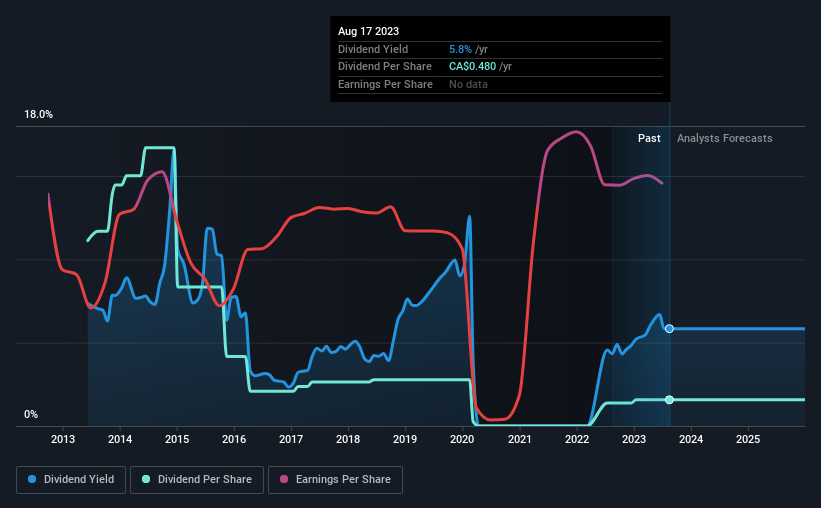
Surge Energy Inc.'s (TSE:SGY) investors are due to receive a payment of CA$0.04 per share on 15th of September. This means that the annual payment will be 5.8% of the current stock price, which is in line with the average for the industry.
View our latest analysis for Surge Energy
Surge Energy's Payment Has Solid Earnings Coverage
We aren't too impressed by dividend yields unless they can be sustained over time. However, Surge Energy's earnings easily cover the dividend. This means that most of its earnings are being retained to grow the business.
Over the next year, EPS is forecast to fall by 9.6%. If the dividend continues along the path it has been on recently, we estimate the payout ratio could be 17%, which is comfortable for the company to continue in the future.

Dividend Volatility
Although the company has a long dividend history, it has been cut at least once in the last 10 years. The annual payment during the last 10 years was CA$3.40 in 2013, and the most recent fiscal year payment was CA$0.48. Dividend payments have fallen sharply, down 86% over that time. Declining dividends isn't generally what we look for as they can indicate that the company is running into some challenges.
The Dividend Looks Likely To Grow
Given that dividend payments have been shrinking like a glacier in a warming world, we need to check if there are some bright spots on the horizon. It's encouraging to see that Surge Energy has been growing its earnings per share at 32% a year over the past five years. Rapid earnings growth and a low payout ratio suggest this company has been effectively reinvesting in its business. Should that continue, this company could have a bright future.
An additional note is that the company has been raising capital by issuing stock equal to 18% of shares outstanding in the last 12 months. Regularly doing this can be detrimental - it's hard to grow dividends per share when new shares are regularly being created.
Surge Energy Looks Like A Great Dividend Stock
Overall, we like to see the dividend staying consistent, and we think Surge Energy might even raise payments in the future. The distributions are easily covered by earnings, and there is plenty of cash being generated as well. If earnings do fall over the next 12 months, the dividend could be buffeted a little bit, but we don't think it should cause too much of a problem in the long term. All of these factors considered, we think this has solid potential as a dividend stock.
Market movements attest to how highly valued a consistent dividend policy is compared to one which is more unpredictable. However, there are other things to consider for investors when analysing stock performance. To that end, Surge Energy has 4 warning signs (and 1 which is a bit concerning) we think you should know about. If you are a dividend investor, you might also want to look at our curated list of high yield dividend stocks.
New: Manage All Your Stock Portfolios in One Place
We've created the ultimate portfolio companion for stock investors, and it's free.
• Connect an unlimited number of Portfolios and see your total in one currency
• Be alerted to new Warning Signs or Risks via email or mobile
• Track the Fair Value of your stocks
Have feedback on this article? Concerned about the content? Get in touch with us directly. Alternatively, email editorial-team (at) simplywallst.com.
This article by Simply Wall St is general in nature. We provide commentary based on historical data and analyst forecasts only using an unbiased methodology and our articles are not intended to be financial advice. It does not constitute a recommendation to buy or sell any stock, and does not take account of your objectives, or your financial situation. We aim to bring you long-term focused analysis driven by fundamental data. Note that our analysis may not factor in the latest price-sensitive company announcements or qualitative material. Simply Wall St has no position in any stocks mentioned.
About TSX:SGY
Surge Energy
Explores, develops, and produces oil and gas in western Canada.
Undervalued with adequate balance sheet.
Market Insights
Community Narratives



